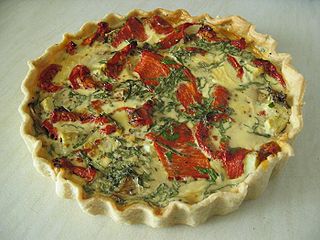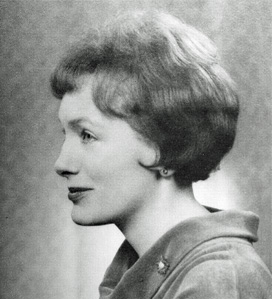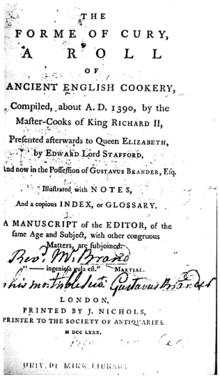
Blancmange is a sweet dessert popular throughout Europe commonly made with milk or cream and sugar thickened with rice flour, gelatin, corn starch, or Irish moss, and often flavoured with almonds.

English cuisine encompasses the cooking styles, traditions and recipes associated with England. It has distinctive attributes of its own, but is also very similar to wider British cuisine, partly historically and partly due to the import of ingredients and ideas from the Americas, China, and India during the time of the British Empire and as a result of post-war immigration.

A recipe is a set of instructions that describes how to prepare or make something, especially a dish of prepared food. A sub-recipe or subrecipe is a recipe for an ingredient that will be called for in the instructions for the main recipe.

Lasagna is a type of pasta, possibly one of the oldest types, made of very wide, flat sheets. Either term can also refer to an Italian dish made of stacked layers of lasagna alternating with fillings such as ragù, béchamel sauce, vegetables, cheeses, and seasonings and spices. The dish may be topped with grated cheese, which becomes melted during baking. Typically cooked pasta is assembled with the other ingredients and then baked in an oven. The resulting baked pasta is cut into single-serving square or rectangular portions.

A posset was originally a popular British hot drink made of milk curdled with wine or ale, often spiced, which was often used as a remedy.

Quiche is a French tart consisting of pastry crust filled with savoury custard and pieces of cheese, meat, seafood or vegetables. A well-known variant is quiche Lorraine, which includes lardons or bacon. Quiche may be served hot, warm or cold.

A cookbook or cookery book is a kitchen reference containing recipes.

Apicius, also known as De re culinaria or De re coquinaria, is a collection of Roman cookery recipes, which may have been compiled in the fifth century CE, or earlier. Its language is in many ways closer to Vulgar than to Classical Latin, with later recipes using Vulgar Latin added to earlier recipes using Classical Latin.

The Liber de Coquina is one of the oldest medieval cookbooks. Two codices that contain the work survive from the beginning of the 14th century. Both are preserved at the Bibliothèque Nationale in Paris, France.

Le Viandier is a recipe collection generally credited to Guillaume Tirel, alias Taillevent. However, the earliest version of the work was written around 1300, about 10 years before Tirel's birth. The original author is unknown, but it was common for medieval recipe collections to be plagiarized, complemented with additional material and presented as the work of later authors.

Figgy pudding or fig pudding is any of many medieval Christmas dishes, usually sweet or savory cakes containing honey, fruits and nuts. In later times, rum or other distilled alcohol was often added to enrich the fruitiness of the flavour.

Fricassee or fricassée is a stew made with pieces of meat that have been browned in butter then served in a sauce flavored with the cooking stock. Fricassee is usually made with chicken, veal or rabbit, with variations limited only by what ingredients the cook has at hand.
Hodge-podge or hotch potch is a soup or stew, usually based on diced mutton or other meat, with green and root vegetables. It is familiar in different versions in Britain and North America and is particularly associated with Scotland.

The Good Huswifes Jewell is an English cookery book by the cookery and housekeeping writer Thomas Dawson, first published in 1585. It includes recipes for medicines as well as food. To the spices found in Medieval English cooking, the book adds herbs, especially parsley and thyme. Sugar is used in many of the dishes, along with ingredients that are uncommon in modern cooking like violets and rosewater.
A mortis, also spelt mortrose, mortress, mortrews, or mortruys, was a sweet pâté of a meat such as chicken or fish, mixed with ground almonds, made in Medieval, Tudor and Elizabethan era England. It is known from one of England's earliest cookery books, The Forme of Cury (1390), and other manuscripts.

Rabbit stew, also referred to as hare stew when hare is used, is a stew prepared using rabbit meat as a main ingredient. Stuffat tal-Fenek, a variation of rabbit stew, is the national dish of Malta. Other traditional regional preparations of the dish exist, such as coniglio all'ischitana on the island of Ischia, German Hasenpfeffer and jugged hare in Great Britain and France. Hare stew dates back to at least the 14th century, and was published in The Forme of Cury during this time as a recipe for stewed hare. Rabbit stew is a traditional dish of the Algonquin people and is also a part of the cuisine of the Greek islands. Hare stew was commercially manufactured and canned circa the early 1900s in western France and eastern Germany.
Utilis Coquinario is an English cookery book written in Middle English at the turn of the fourteenth century. The title has been translated as "Useful for the Kitchen". The text is contained in the Hans Sloane collection of manuscripts in the British Library and is numbered Sloane MS 468.

Constance Bartlett Hieatt was an American scholar with a broad interest in medieval languages and literatures, including Old Norse literature, Anglo-Saxon prosody and literature, and Middle English language, literature, and culture. She was an editor and translator of Karlamagnús saga, of Beowulf, and a scholar of Geoffrey Chaucer. She was particularly known as one of the world's foremost experts in English medieval cooking and cookbooks, and authored and co-authored a number of important books considered essential publications in the field.

This Is the Boke of Cokery, or The Boke of Cokery, is believed to be the first cookery book printed in English. The name of the author is unknown. It was printed and published by Richard Pynson in 1500. The book remained in print for many years in the 16th century, but was superseded and forgotten by the 18th. The only known surviving copy of the book is in the possession of the Marquess of Bath at Longleat House, Wiltshire.

















